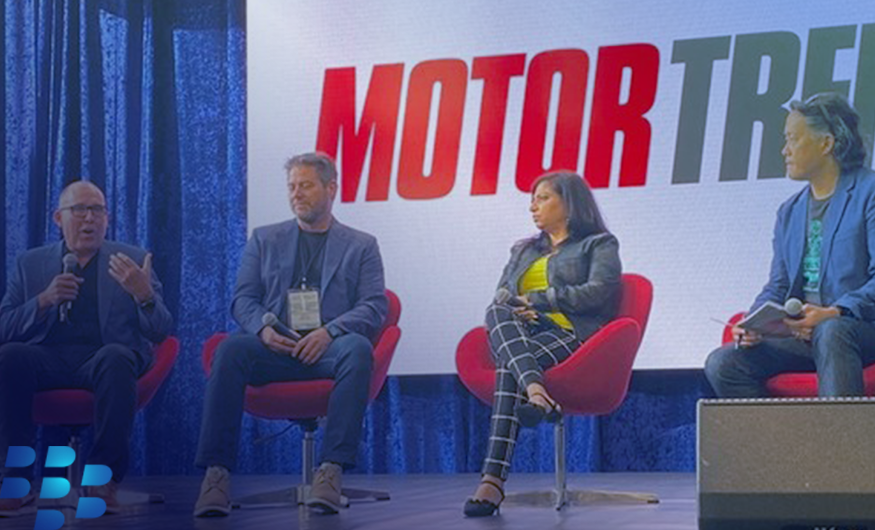Software Defined Vehicles and EVs – Can They Win Over Car Enthusiasts?

Spiking fuel prices around the globe during 2022 helped goose the “sales engine” of electric vehicles (EVs). However, EVs still have an image problem with those who love a combustion-powered V8 roaring under the hood.
Industry leaders discussed this topic with MotorTrend head of editorial, Ed Loh, at this year’s North American International Auto Show (NAIAS) in Detroit. The automotive industry panelists explained how advanced software features will help win over more drivers — even V8 lovers — to electrification.
Electric Vehicles vs. Combustion V8s
Rationally, EVs make a lot of sense. They are smooth to drive and can be much cheaper per mile than gas-driven cars. But diehard lovers of the V8 engine remain unmoved. They worry they will miss the drama of a growling exhaust pipe and screaming pistons, even if the result of all that noise is often slower acceleration than an EV. Now, however, electric vehicles have another secret weapon – their drivetrains work seamlessly alongside the trend toward software-defined vehicles (SDVs).
“When you listen to an EV there is no sound,” says Mamatha Chamarthi, Head of Software Business and Product Management, Stellantis, speaking at the Detroit Auto Show. “But I love my internal combustion engine. I love the sound of a Dodge Challenger Hellcat. If I'm driving an EV, I want the feel of the Hellcat. I want the sound and I want the vibration. I want that amplification.” Stellantis answered this challenge with its Dodge Charger SRT Concept EV amusingly named “Fratzonic Chambered Exhaust.” It is part of the car’s powerful Banshee electric drivetrain. This provides a performance sound pushed through a tuning chamber located at the rear of the vehicle. “I get the same sound that I hear in my Challenger Hellcat. It's 120 decibels.”
This is just one example of what is becoming possible.
SDVs and Customization
The beauty of a system like the one in the Hellcat is that it is software controlled, so it can be customized by the driver. It is even possible to give a vehicle an entirely unique sound — in a similar fashion to custom cell phone ringtones. Or, when arriving home late in a quiet residential neighborhood, you could turn the sound off completely.
And this strategy of adding unique noise is being followed by other manufacturers as well, albeit in a less extreme form. The Ford Mustang Mach-E can produce engine-like noises, and BMW is offering audio designed by legendary Hollywood composer Hans Zimmer for its EVs. Both primarily benefit the driver and passengers.
Increasing Benefits of EVs
But while some will appreciate the ability to put a bit of noise back into an EV, the superior performance and features they have vs. internal combustion, are likely to provide the most compelling arguments. In fact, the performance an EV is capable of is one of the big surprises people have when they encounter them. “The other day, I was behind a Tesla Model S 90D,” says John Wall, senior vice president and head of operations, technology solutions, at BlackBerry QNX. “There were two lanes merging into one lane, and I have never seen a vehicle launch like that car. No sound and it was gone!”
An electric vehicle can have more power than ever before, but still be whisper quiet, such as the 1,000hp Hummer EV.
“I can drive through my neighborhood at midnight, and it doesn't wake anybody up, but the performance is there,” says Scott Miller, vice president of software-defined vehicle and operating system at General Motors. During the panel at the Detroit Auto Show, he explained how software combined with electrification can also provide exciting new features to delight the driver. “The Hummer EV has crab mode, too.” This function uses four-wheel steering to enable sideways motion and a tighter turning circle, enabled by the electric motors driving the wheels independently. It makes maneuvering the huge Hummer EV in tight spaces much easier than it should be.
Electrification and connectivity can enable significant savings in running costs for both individual and fleet owners, both due to the efficiency of EVs and their reduced need for maintenance. The latter can even be performed remotely via over-the-air software updates. “When I talk about the balance sheet, that's when I can get everyone around me excited about the transition to EVs,” says Chamarthi. “It's the experience that people are looking for.”
Saving money isn’t going to get everyone excited, particularly when there is still a significant premium to buying an EV. But connected features could, such as remote-control options for cabin cooling, heating, and screen defrosting. The truly “killer app” will be autonomous driving, enabling your car to be your automatic taxi when you don’t want to control it directly yourself.
“The future is going to be unbelievable, because of the creative ways to make it exciting,” says Miller. “We're building a whole portfolio because EVs are awesome. You don't have to say: ‘It's a nice car, but it's this or it doesn't have that’. We're at that tipping point where you will start to see the market reaction to the new features. EVs are awesome luxury vehicles. They make fantastic general transportation vehicles. And then we add the software-defined part on top of them, and people will ask how we lived without it before.”
“If you go into the Auto Show and go to the Jeep exhibit, you will see the power of the Jeep,” says Chamarthi. “It can scale 25 feet vertically up and down.” In the past, you needed to know how to make the most of this capability. “But imagine me driving, I don't know how to go for low gearing and how to engage and disengage things in the car. With a software-defined vehicle, it will start in real-time coaching me how to do all those things.” The car can become an assistant, tailoring the car setup to the driver. “It will collect my data and then tell me exactly the experience I want and the music that I want to listen to as I'm going through it.”
“Software has been playing an important role for the last few years,” concludes Wall. “One example would be customizing the reconfigurable instrument clusters. This is becoming a very common feature within a vehicle. You can customize the look, such as having a sport mode and non-sport mode. Infotainment has also progressed over the last few years and there has been a large movement to Android™, adding a lot of features that people want. We're seeing automatic features for Advanced Driver Assistance Systems (ADAS), for instance, that are largely based on software.”
Future EVs and Driving Enthusiasts
There is no escaping the fact that EVs won’t naturally have the dramatic soundtrack of internal combustion and attempts to re-inject that such as the Fratzonic Chambered Exhaust might still not be enough to win over some critics. However, the gut-wrenching performance EVs can provide alongside the innovative and expandable software platform enabled by SDVs deliver something different that can be even more pleasing.
Just as we now find we can barely live without our smartphones, a connected, software-defined EV can offer lifestyle-changing capabilities.
New Automotive Awards Category
The fundamental importance of software-defined vehicles to the future of the automotive industry is now recognized via the partnership between BlackBerry and MotorTrend, and the creation of a new category of automotive awards for software-defined vehicle innovators.
To focus attention on the fundamental importance of software-defined vehicles to the future of the automotive industry, and the contributions of the visionary individuals bringing it about, MotorTrend Studios has produced an exclusive 22-minute documentary. The online film release is among several editorial activities taking place this fall, leading up to a gala SDV Innovator Awards show scheduled during the 2023 Consumer Electronics Show in Las Vegas next January.

